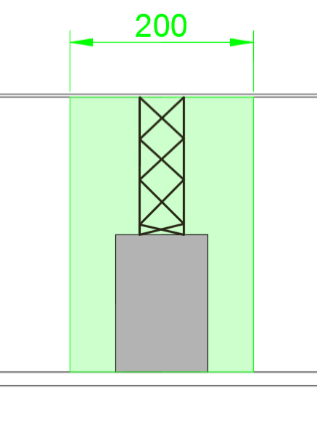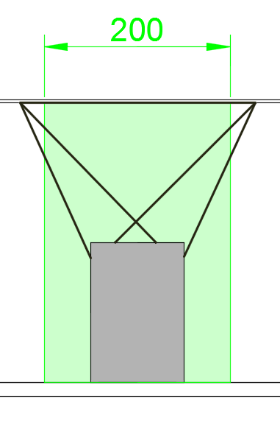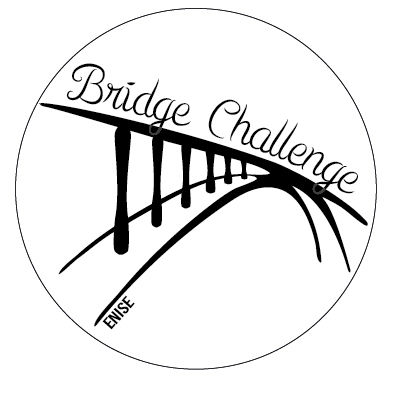Description
Each team is made up of between 2 and 4 members. They will have to make in one day (9 hours) a model of a bridge which conforms with all the rules presented in the following paragraphs. Each member must be a student in a higher education establishment. The teams will have to think about the structure of their bridge before the competition and which material they wish to use, and they will have to make blueprints of their bridge. On Sunday morning, each bridge will be assessed, then tested in term of weight resistance until it brakes
Calendar
■ Registration will be open from the 10th January, 2019 using the web site in the tab called “inscription” in French, or “registration” in English on the web page which describes the contest planned for 2019.
■ Registration will be closed when the number of teams has reached the number necessary for the smooth functioning of the contest. If this number is not reached, registration will be closed the 10th March, 2019.
■ Each team must send, before the 10th March, 2019, the registration fee and a copy of the student cards of each team member to the address or in e-mail (bcenise@gmail.com):
Bridge Challenge ENISE
58 rue Jean Parot
42100 Saint-Etienne
■ The contest will take place during the weekend of the 23th to 24th March, 2019, at Saint Etienne, “Place Chavanelle”.
Registration fee
The registration fee corresponds to the charge to participate in the Bridge Challenge Enise. For each member of the team who wishes to be housed, an extra fee will be requested. All the food, the Saturday party and the construction materials will be paid by the organisers.
Registration fee are 20 € per team :
Team of 4 members: 5€ (about £4.5) per member without hotel
Team of 3 members: 7€ (about £6.3) per member without hotel
Team of 2 members: 10€ (about £9) per member without hotel
Please, add 20€ (about £18) per member if you wish to be housed in a hotel on Saturday night. Please note that places are limited.
Payment should made by cheque, payable to “Bridge Challenge ENISE”, or by bank transfer (RIB =the details of your personal bank, will be sent when you have completed the registration form)
Materials
Here are the materials that are provided for each team:
■ 1 board of medium (in French) for the deck, thickness 3, width 140, length 1600 mm
■ 1 board of triply (in French) for the plinth of the bridge, thickness 15, width 670, length 2050 mm
■ 2 blocks of cellular-concrete (in French) siporex 200x250x300 mm and 1 block 100x250x150 mm
■ 1 pot of glue for wood (160g), 1 tube of super glue (5g), kitchen twine 2mm (resistance 65kg, 15m in length), fishing line (resistance 6kg, 40m in length)
■ Different cuts of balsa wood (sticks of 1m). Each team will have to choose which quantity of each size they wish to use to construct the bridge from 75g to 291,06g.
The different sizes are:
10×10 mm or 14 g per stick (6 pieces per team maximum)
6×6 mm or 5.06 g per stick (12 pieces per team maximum)
3×3 mm or 1.26 g per stick (18 pieces per team maximum)
3×5 mm or 2.1 g per stick (15 pieces per team maximum)
5×10 mm or 7 g per stick (6 pieces per team maximum)
3×10 mm or 4.2 g per stick (12 pieces per team maximum)
Other elements are strictly forbidden.
Materiel
Other materials will be available: metre, small ruler, cutter, sand paper, a 300 mm saw, a crayon, a bracket and 4 different sizes of wood scissors. However, you can bring your own material. If electric it must be cordless. The batteries can be charged-up before but not during the competition because there is no access to electricity.
Constaints
The length of the bridge must be 1500 mm.
It is strictly forbidden to cut a block of siporex in two and use it to reduce the length of the bridge that must be supported. However, you can remove parts of the blocs.
The blocks of siporex (200 x 250 x 300) that needed to anchor the bridge will be spaced at a distance of 1.50 m. As you can see on the schema:
A surface of 100 x 1440 mm on the apron will have to be free so we can add weights to check the bridge’s resistance.
The two templates (in French) must be able to go under the bridge. Here are the dimensions (in red):
The boards of medium and triply can be cut and drilled, but any pieces cut-off cannot be used to strengthen the structure.
The sticks of balsam cannot be positioned on the board of triply.
The kitchen twine as well as the fishing line cannot be used as reinforcement in the apron, they can be used only on the implementation of a bridge with shroud, underlain bridge, suspension bridge, …
It is allowed, but not compulsory, to use the block of siporex situated in the middle, but with certain conditions.
It is forbidden to create a stack-like structure between the central siporex block and the apron because the bridge would be hyperstatic and it would collapse due to an equilibrium problem and not really due to defective resistance, which is why we created the Rule: any balsa stick (even cut) in the green zone (on the drawings) must exit this area. In other words, a stick (even cut) cannot be entirely situated in the green zone.
For example:
 |  |
| Non accepted | Accepted |
Contest
Every group will realize a poster presenting its bridge (architectural choices and choice of structure) before the date of the competition as well as the plans of the bridge.
During the weekend, the teams will build the bridge on Saturday, and on Sunday a jury will assess the structure, then weights will be used to estimate its resistance.
We will add weights until the bridge breaks.
The bridge will be considered to be broken when it breaks completely or when it bends more than 10 cm vertically.
Each team will prepare a poster (to present briefly the architectural choices and some measurements) representing the bridge before the beginning of the contest.
Assessment system
■ engineering (30 points)
| Feasibility of making the bridge in real life | 10 points |
| Logical structural choices | 10 points |
| Justification of the technical choices | 10 points |
■ architecture (40 points)
| Quality of the construction | 5 points |
| Harmonie of the structure (proportions) | 10 points |
| Architectural innovation | 10 points |
| The drawings correspond to the model | 5 points |
| Total | 30 points |
Awards
■ the engineering award (1st, 2nd and 3rd position)
■ the architectural award (1st, 2nd and 3rd position)
■ the resistance award (1st position)
■ the public award (1st position)
Strength of the model
The teams will not be able to take back their model even if it doesn’t break because the organisers might use them to advertise the Bridge Challenge ENISE.
Acceptation of the rules
Registration for the contest means that the candidates accept the rules governing the competition. The members of the teams must participate for the whole contest from the 23th – 24th March, 2019.
Intellectual property
Participants accept the use of their identity and the presentation of their project for promotional or advertising purposes in connection with this competition, for example, brochures, flyers, posters, press articles, website, etc.).
Each candidate agrees to allow the organizer and his partners the right to use his image, his surname and first name with photographs, interviews or videos taken during the contest. They can be used by the organizer and its partners to promote the competition (internal communication, external communication, paper, video, internet etc).
The organiser undertakes, however, not to disseminate the details of the participants to third parties without their consent.
Possible modifications
The organisers can change at any time the competition and the judges can take any decisions necessary so that the competition can progress smoothly. The organisers can inform the participants by any means of communication. The organisers can modify, extend, shorten, suspend or cancel the contest, without notice, whatever the reason. The organisers can invalidate and/or cancel all or parts of the contest if there is a fraud or a dysfunction in any form by the participants during the contest or when the winners are being decided. The organisers can decide not to give an award if a team has cheated in the organisers’ opinion and/or sue the members of the team that have cheated. The fraud leads to the disqualification of the team. The staff and the team’s sponsor are not responsible if their team is disqualified. The team that cheated and his legal representation can’t expect any compensation or indemnity.
Computing and freedom
To participate in the contest, the participants must provide personal information (first name, second name, email, telephone etc)
The collection of this information is necessary so the competition can progress smoothly. This information is saved in a computer file during the competition. This information is for the staff. If there is any problem in the personal information, the participant can’t participate in the contest. The information will not be conserved after the end of the contest.
Due to the law, number 78-17 of the 6th January, 1978, about the information stored in the form of computer files and freedom of information, the participants have a right to refuse its use, access, rectify and delete the information about them. In order to do this, the participant must send an email. (take a look at the part “who are we” on the site web).


